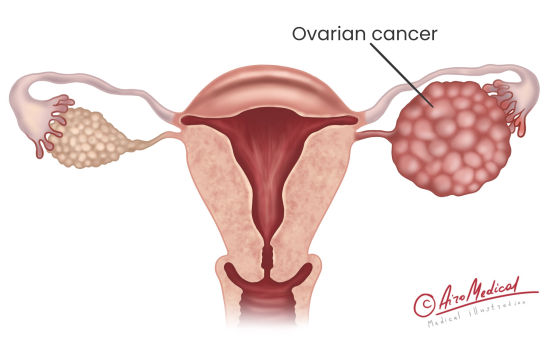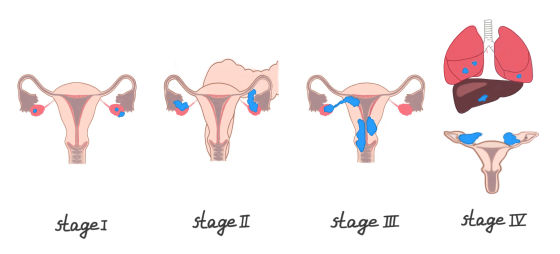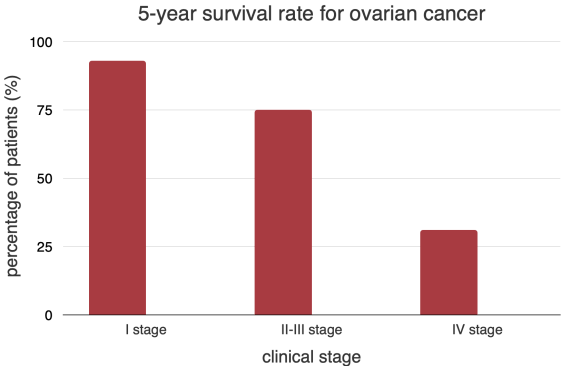Ovarian Cancer Guide

About 1 in 78 women will get ovarian tumors at some point.
Breastfeeding for 12 months decreases the chance of getting ovarian cancer by 34%.
Women with a BRCA1 mutation have a 35% to 70% chance of malignancy in their ovaries.
Between 20% and 25% of women with malignant neoplasm in ovaries have a family history.
 Shortly info about women’s reproductive glands
Shortly info about women’s reproductive glands
The ovaries are an essential part of how a woman reproduces. There are two ovaries, each about four centimeters long, and they have an oval shape. They are on either side of the uterus and stay in place because of the ligaments attached to them.
There are two main ways that the ovaries help the body make babies. They produce oocytes, eggs that can be fertilized, and the hormones estrogen, progesterone, and androgens.
A 28-day menstrual cycle has phases that happen in the ovaries. Ovulation occurs mid-cycle.
Menopause is the end of a woman's reproductive years, which happens about 51 years after her last period when the ovary has lost its few follicles. When no more follicles (each holding an egg), the ovary stops making the hormones estrogen and progesterone, which control the menstrual cycle. Because of this, menstrual cycles and periods will stop happening.
 What is ovarian cancer?
What is ovarian cancer?
Malignancy occurs when DNA changes happen, and cells begin to divide without control. Tumors can grow from these cancer cells; if they aren't treated, they could spread to other body parts.
 Treatment methods and prognosis depend on what kind of cancer it is. So it’s essential to determine the “name” of cancer. There are different types of ovarian cancer:
Treatment methods and prognosis depend on what kind of cancer it is. So it’s essential to determine the “name” of cancer. There are different types of ovarian cancer:
- Epithelial tumors are the most common type (90% of cases) and include serous, clear cell, mucinous and endometrioid carcinoma.
- Stromal tumors are a rare type (about 2%) of tumors usually found and treated earlier than other cancerous growth. There are teratoma, dysgerminoma, and endodermal sinus tumors, choriocarcinoma. Typically have a better prognosis.
- Germ cell tumors, a rare type (about 1%), typically happen in younger women.
Neoplasms in ovaries remain the most deadly type of gynecological cancer. Less than half of patients live more than five years after their diagnosis. Women of all ages can get ovarian cancer, usually found after menopause. More than 75% of women who have it are diagnosed late because the early stages of the disease typically don't cause any symptoms, and the late-stage symptoms aren't particular.
 Ovarian cancer risk factors
Ovarian cancer risk factors
No one can say for sure if a woman gets ovarian cancer. But the risk can be raised by several things, such as middle age and older or having:
- family history;
- a change in their genes called BRCA1 or BRCA2;
- breast, uterus, or colon cancer;
- endometriosis;
- pregnancy problem.
Some studies also show that women who take estrogen without progesterone may have a higher risk of getting ovarian cancer.
Even if one or more of these things are true, it does not mean women will get the tumor. However, it would help if the patient discussed the risk with a doctor.
Some words about prevention
There is no recognized way to stop the malignancy development. However, these things make it less likely that you will get it:
- Taking birth control pills for at least five years.
- Having had both ovaries taken out, the tubes tied, and a hysterectomy.
- Having given birth.
- Breastfeeding for a year or more.
Even though these things may help lower the risk, not everyone should do them, and each has pros and cons.
 What are the symptoms of ovarian cancer?
What are the symptoms of ovarian cancer?
Especially in the early stages, the signs are unclear. They are usually put down to other, more common illnesses when symptoms appear.
Some of the warning symptoms of ovarian cancer are:
- Abdominal bloating or swelling;
- Getting full rapidly when eating;
- Lose weight;
- Pain in the area around the pelvis;
- Tiredness;
- Backache;
- Changes in how you go to the bathroom, like constipation;
- A need to urinate often.
Any of these signs can be ovarian cancer symptoms.
 Diagnostic tests
Diagnostic tests
The first step is to get a gynecological exam, which usually includes an exam of the pelvis. Next, the doctor puts two fingers into the vagina and presses with the other hand on the abdomen. If ovarian cancer is thought to be a possibility, the oncologist-gynecologist will order more tests:
- A doctor orders a blood test to see if a patient has enough red blood cells, white blood cells, and platelets (cells that help stop bleeding). There will also be tests to determine how well the kidneys and liver work and how healthy a woman is. The doctor will also order a CA-125 test. It's used for screening or has already been used to diagnose. A gynecologic oncologist is often recommended for women with a high CA-125 level. Still, any woman who thinks she might have ovarian cancer should also see one.
- Ultrasound is done with a scanning device put into the vagina (transvaginal scanning) or outside the body (external scanning or abdominal scanning). Ultrasound utilizes sound waves to make an image on a video screen. It is the first test the doctor ordered when something might be wrong with the ovaries. An oncologist can use it to find an ovarian tumor and determine if it is a tumor or a liquid cyst. It can also be used to better look at the ovary to see the details.
- CT scan: Using x-rays, detailed pictures of the organs inside the body are taken from different angles. When the computer puts all these images together, the doctor gets a clear picture of any changes or new formations. Abdominal and pelvic CT takes pictures of the whole belly and is used to help figure out what is causing abdominal or pelvic pain and find the tumor in the ovaries. It is used to look for signs of ovarian cancer spreading. During the exam, the lymph nodes and other tissues are often easier to see when contrast material is injected into a vein or taken by mouth.
- An MRI (magnetic resonance imaging scan) uses a strong magnet and radio waves to get clear pictures of organs inside the body. Based on the American Cancer Society (ACS) and other institutions, doctors do not commonly use an MRI to check for ovarian cancer. Most of the time, they use this imaging scan to look for where cancer may have spread or to find other cancers affecting the spinal cord or brain.
- PET (positron emission tomography) Radioactive glucose (sugar) is used in a PET scan to look for cancer. Body cells take in various amounts of sugar depending on how fast they grow. Since cancer cells multiply, they are more likely to absorb more sugar than other cells. A special camera takes a picture of places in the body with radioactivity. The image from a PET scan isn't as straightforward as from other scans, but it can help tell if spots found by other tests are likely to be cancer.
- If a woman already has a tumor, the doctor may use this test to see if it has spread to her lymph nodes or other parts of her body. A PET scan can also help if the doctor thinks cancer has spread but doesn't know where. Some devices can do both a PET scan and a CT scan simultaneously. PET scans can help find cancer that has spread, but they are not used to look precisely for ovarian cancer.
- Laparoscopy is performed when the doctor looks at the ovaries and other organs and tissues in the pelvic area through a thin, lit tube. A small cut is made to insert the tube, which sends images of the abdomen or pelvis to a video monitor. Laparoscopy gives doctors a look at the organs, which can help them plan surgery or other treatments and confirm the cancer stage. Also, doctors can take biopsies by moving small instruments through the laparoscopic cut.
- A biopsy is one of the most accurate ways to diagnose ovarian cancer. A tiny piece of suspected tissue is cut off with a needle to examine it under a microscope. A pathologist then checks the tissue for cancer cells.
The tests will help make a correct diagnosis and determine what kind of tumor is spreading to other organs.
Stages of ovarian cancer

Cancer in its early stages I and II:
- In stages IA and IB, the cancer is confined to one or both ovaries. The tumor hasn't broken through the capsule or membrane that covers the ovaries.
- In stage IC disease, either the ovary's capsule may have broken, or there may be signs that cancer cells have started to spread in the pelvis.
- In stage II, the tumor has spread to other organs in the pelvis, like the uterus or fallopian tubes. There may be early signs that cancer has spread outside the pelvis.
Ovarian cancer is in an advanced stage when it is in stages III and IV:
- The process has progressed to the abdomen in stage III to the lymph nodes but no other body parts.
- Cancerous cells have spread to other body parts, like the liver or lungs, in stage IV disease.
Where to go to treat ovarian cancer?
 Treatment methods
Treatment methods
There are several ways to treat ovarian cancer. Since each case is different, there may be more than one way to treat the same cancer. Also, oncologists can use cancer treatments alone or with other therapies. Doctors will suggest the best treatment based on the type and stage of the disease, the person's genes, age, and overall health.
- Systemic chemotherapy: drugs that kill cancer cells (called "cytotoxic" drugs). Most drugs are given through an IV or are taken by mouth. Most schedules are based on cycles that happen over a certain amount of time. The method helps eliminate some cancer cells and shrink the tumor. It can be operated on again or fight metastases.
- Hormone therapy: Drugs that stop hormones that cancer cells need to grow. This method uses the feature that the growth of cancer cells depends on certain hormones. When hormones are prevented from doing their job, the development of cancer cells slows down or stops. This type of standard therapy is infrequently used to treat epithelial ovarian cancer. Instead, it is more commonly employed to treat ovarian stromal tumors.
- Targeted therapy focuses on specific parts of cancer cells, like the genes and proteins that help cancer grow and stay alive. The method makes it possible to find cancer cells and only attack them, stopping them from doing their job without hurting healthy cells. It prevents cancer cells from growing and spreading without harming healthy cells.
- Radiation therapy: X-rays or particles with much energy are used to kill cancer cells. Radiation therapy is infrequently used as the primary therapy for ovarian cancer because aggressive chemotherapy works better most of the time. But it can help if cancer has spread near the primary tumor or in an organ far away, like the brain or spinal cord.
- Surgery is the standard way to treat ovarian cancer. It includes:
- Removal of one ovary: This is done when an ovarian neoplasm is in its early stages. Surgery may only involve removing one ovary and one fallopian tube. This kind of Surgery helps a woman keep her ability to have children.
- Two ovaries are removed when a tumor has grown on both ovaries. Both ovaries and the fallopian tubes are taken out. In this case, there is no damage to the uterus. Women could also get pregnant with a donor's frozen eggs or eggs.
- Removal of the ovaries and uterus: If cancer has spread to nearby organs, the ovaries, fallopian tubes, uterus, lymph nodes, and abdominal fat are all removed. The ability to have children is not kept.
- In surgery for advanced cancer, the surgeon takes out the most cancerous tumor. Before and after surgery, the doctor recommends chemotherapy.
When advanced ovarian cancer is found, it can be hard or even impossible to treat. In this case, the team of doctors has to stop cancer from spreading and treat its symptoms to make the person live longer and better.
What clinics perform diagnostic and treatment?
 New ways to treat illness
New ways to treat illness
Even though treatment protocols and clinical trials have been improved, there have only been small gains in survival. So, ovarian cancer is still the most dangerous type of gynecological cancer. Patients need to know the latest discoveries about what causes ovarian cancer and how to diagnose and treat it.
- Transarterial chemoembolization (TACE) for metastases is a minimally invasive procedure for treating metastases from ovarian cancer. A chemotherapy drug is injected directly into the affected area (through the vessels). The blood supply is cut off when the blood vessels that feed the tumor are blocked (called "embolization"). It keeps the chemotherapy inside the neoplasm.
- Transarterial chemoperfusion (TACP) for metastases is when a chemotherapy drug is injected directly into the blood vessels that feed the tumor. With a high dose and point exposure, tumor cells are killed. This method is often used for far-off metastases in hard-to-reach places.
- Proton therapy is a radiotherapy in which a beam of protons containing a certain amount of radiation is sent directly to the affected area. Protons don't hurt healthy tissues, but they do damage the tumor.
- Ablation therapy (RFA, MWA, ethanol) uses needle electrodes to deliver tumor heat. It causes ovarian tumors to get smaller and die.
- Surgical treatment (da Vinci robot-assisted ovarian cancer surgery): a surgery that uses a robotic system to remove the affected ovary. With the da Vinci system, gynecological surgeries can be done with more minor cuts, which cuts down on complications and the time it takes to heal.
Treatments have come a long way because of the methods listed above. Also, it gives many women hope and better outcomes, even in the last stages of the disease.
What doctors treat ovarian cancer?
 Stats and predictions
Stats and predictions
Cancer of the ovaries is women's second most common type of cancer. It kills more people than any other cancer of the female reproductive system. Even though only 1.8% of the population is at risk, it is the fifth leading cause of cancer death in women because 60% of women with ovarian cancer have metastatic disease.
According to the American Cancer Society, 93% of women with early-stage will be alive after five years. Cancer in stages II–III has a 75% chance of being cured after five years, while ovarian cancer survival rate in stage IV has a 31% chance of being cured after five years.

So, what should women do next?
Shortly, the treatment will be based on new ideas and combinations of treatments. Our patients get help from trained professionals and use various methods, which have shown to be very effective.
Suppose you or a family member are told she has ovarian cancer. In that case, the most important thing to do immediately is to find a team of experts. Like any other, it is only a problem if you don't know how to solve it. Get help from the AiroMedical squad if you want to know how to get the latest treatments.
Save time, and contact us ASAP. We can help, as do it for years.
References:
- NHS: Overview - Ovarian cancer
- CDC INFORMATION: What Are the Risk Factors for Ovarian Cancer?
- SAGE Publications Ltd: Ovarian Cancer: Diagnostic, Biological and Prognostic Aspects
- American Academy of Family Physicians: Diagnosis and Management of Ovarian Cancer
- American Cancer Society: Survival Rates for Ovarian Cancer
- Cancer Research UK: Ovarian cancer survival
- Cancer Council Victoria: Diagnosing ovarian cancer
















